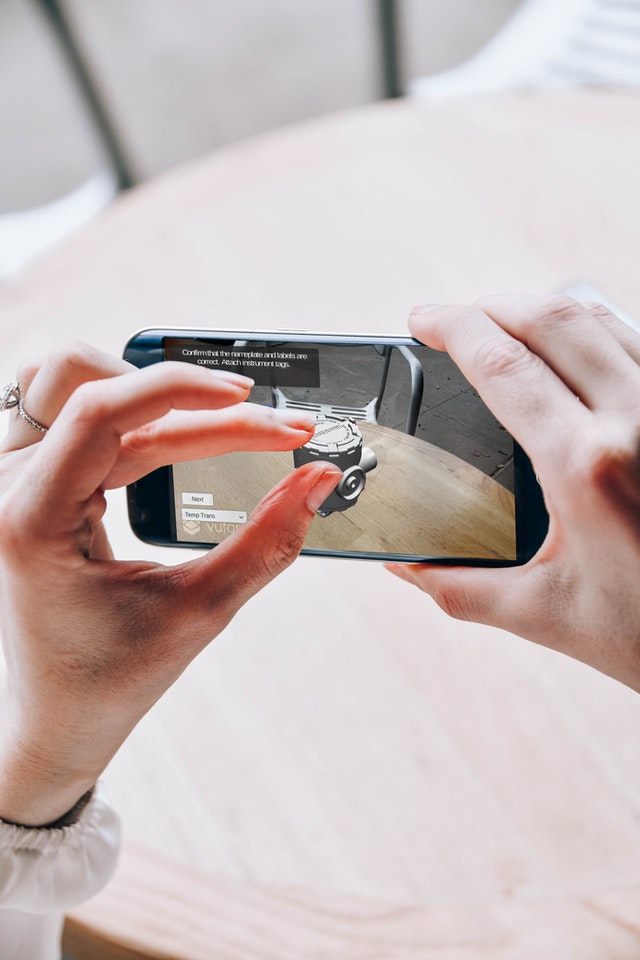Artificial intelligence (AI) has significantly impacted every industry, including tech, health, automotive, manufacturing, and more. If you want to experience the power of AI, your smartphone is the first device you should look at. AI is integrated into almost every major component of the modern smartphone. Most of us use the AI functionalities on our phones without even knowing.
In this article, we will discuss some of the major components of your smartphone that have been integrated with AI. Please note that this article covers both iOS and Android devices because the implementation of AI is almost the same on both platforms.

Smartphone elements that have been impacted by AI
AI Smartphone Cameras


Your smartphone’s camera system is among the major beneficiaries of AI. The regular person today doesn’t need a standalone camera because all their favorite moments can perfectly be captured by any modern smartphone. This wasn’t the case just ten years ago when the quality of smartphone photos was nowhere near that of mainstream cameras.
Due to the size limitation of a smartphone, using the large image sensors that mainstream cameras use is not an option. The only way out was to cheat physics by using computational photography. Computational photography is simply the use of software to enhance the quality of an image beyond what the camera’s hardware can capture.
Smartphone cameras have drastically improved in quality in the last 5 to 7 years, thanks to the improvements in image processing that largely relies on AI and machine learning. iPhones, Samsungs, and Google Pixels are still leading in smartphone photography not because they put the largest sensors in the phones. It is because they have more advanced image processing algorithms than the competition.
Image processing algorithms in smartphones use machine learning models that improve over time the more the image data they are fed. Of course, these algorithms have also hugely benefitted from the more advanced raw power of smartphone processors. All the new smartphone chips come with dedicated image processors whose only role is to speed up the processing of videos and photos recorded by the smartphone’s camera system.
So, as you go out there to buy your next smartphone, hardware specs alone won’t be enough to help you determine the phone with the best camera. For example, the iPhone 13 series still rely on 12MP sensors, but they still do better than some flagships with 108MP cameras. This indicates that the smartphone camera game is not only won with hardware. Image processing that heavily relies on AI is what creates the difference between average and great smartphone cameras.
AI Voice assistants


Every new smartphone today comes with a voice assistant that you can use to give your phone voice commands. Whether you want to set an alarm or add an event to your calendar, you can do all that using a voice assistant without having to touch your phone. Voice assistant uses natural language processing to convert spoken words into actual commands that your phone or computer can understand to do the requested action.
Natural language processing relies on machine learning to convert vibrations from our voices into text or commands. Some of the most popular voice assistants on smartphones include;
- Google Assistant: This is the most popular voice assistant that comes built-in on most Android smartphones and tablets. iPhone users can also download Google Assistant from the App Store. However, the experience on iOS is a little limited compared to Android. Google Assistant’s power largely relies on Google’s huge amounts of data. Google also has also invested a lot in its AI and Machine learning technologies to utilize the massive data they have.
- Siri: This is only available on Apple products, including iPhones, Macs, Home Pod, iPad, and some displays. Siri is also a reliable assistant, especially when it comes to on-device commands such as setting alarms and reminders and controlling other smart home devices. The main weakness with Siri is when it comes to questions that involve using data on the web. On the other hand, Google Assistant shines more on web-based questions.
- Alexa: This is Amazon’s Voice Assistant that works with both iOS and Android devices. It also comes built into most of Amazon’s products, including smart speakers, tablets, TV sticks, and more. It is also a relatively smart voice assistant when compared to Google and Siri. With Alexa, you can play music, search the web, get news and sports scores, learn about the weather, control your smart home and even allow Prime members to order products from Amazon.
- Bixby: This is an exclusive voice assistant that comes with Samsung smartphones and their other lineup of products, including TVs, laptops, and more. It is a pretty reliable assistant, but still not at the level of Google Assistant, Siri, and Alexa. Even if you have a Samsung, Google Assistant will likely do a better job than Bixby.
All the above Voice Assistants have been getting better over time as the companies behind them continue to improve the machine learning models that power them. In the next couple of years, these assistants could even become more capable than they are today.
AI Biometric authentication


Almost every smartphone on the market today has some form of biometric authentication. Apple uses Touch ID or Face ID on all their newer devices, including the iPhone, iPad, and Mac. Most Android devices use Fingerprint scanners that are either built into the display or on the power button.
These biometric authentication systems use machine learning to learn about the user by either capturing the details of their face or fingerprints. Whenever you want to log into your device, they will compare your face or fingerprints to the ones stored in the system to ensure the device’s rightful owner is granted access.
The newer versions of Apple’s Face ID (iPhone 12 or newer) can also recognize someone even when they put on a mask. These advancements have all been possible due to the gradual improvements in the hardware and machine learning models of biometric authentication systems.
AI On-device search


Searching for files on your smartphone is now easier than ever before, thanks to the integration of AI in the smartphone’s search engines. For example, spotlight search on iOS is now able to search for texts in images and include them in the search results. You can also search for images using the names of the objects in those images.
For example, if you want to see all the dog photos on your iPhone, you simply have to search for them by typing in the query “dog” in the spotlight search. You can also search images for most everyday items and animals by simply using their names as the search query. This is a very handy feature in this era, where most people have thousands of images on their smartphones.
AI On-device dictation


Both iOS and Android support on-device dictation, where you simply have to speak out the words, and your phone converts them into text. This is all possible because of the massive processing power of smartphone chips and the sophisticated natural language processing systems that these devices come with.
This feature is even more helpful to people with physical limitations that prohibit them from typing words using their hands. On-device dictation continues to get better the more you use it on your device as the machine learning models get used to the tone of your voice and your accent.
AI Sound recognition


Our phones can now recognize different sounds, including fire alarms, sirens, dogs, cats, and more. You can also set your phone to notify you whenever it detects any of these sounds. This is a very handy feature, especially when you are using earphones that block out all external sounds. People with hearing problems are also major beneficiaries of these features.
AI Text detection in images and videos


If you have a newer smartphone running the latest Android or iOS, you can easily copy texts from images and videos. You simply have to long press the text in the image and highlight what you intend to copy. It is just similar to copying text in a word document or PDF. This feature is called live texts on iOS and Google lens on Android.
iOS has gone on to introduce this feature in videos too. If you are running iOS (which is still in Beta at the time of writing this article), you can simply pause a video and copy any text that you see in that frame. For instance, if you are watching a tutorial on your phone, you can simply copy any text in the video and add it to your notes.
AI Autocorrect functionality in keyboards.


Autocorrect is one of the most underrated features of our smartphones. Just imagine how long it would take you if you had to manually type every word while texting on iMessage or creating a long caption for your LinkedIn post. The good news is that with autocorrect, we don’t have to type everything; you simply have to type a few letters, and your phone’s keyboard will predict the next words you intend to type.
These keyboards can also predict the next word based on your typing history. This feature alone can save us over 30% of the actual time we would spend writing content on our phones. Autocorrect uses AI to learn the most common words you use while writing certain sentences. These keyboards can also suggest the most appropriate emojis that you can use to complement a given the word or phrase.
AI Face recognition in photo apps


Another major implementation of AI on our smartphones is in the photo apps that are now able to recognize people’s faces. Photos apps can now identify a similar face if it appears in several photos in your gallery. These apps also recommend adding a name to the different faces, making it possible to search for that person’s images using their name.
Face recognition in these apps makes it much faster for us to find photos of our friends without having to browse through thousands of irrelevant images.
Limitations of AI
Despite the advancements in AI on our phones, there is still work to be done to improve our experience. Some of the AI limitations on our phones include the following;
- Fewer languages supported: Most of the voice-related capabilities we mention above are only available in popular languages, such as English, Chinese, Spanish, French, and more. You cannot use a non-supported language to do a voice command. So, take time to find out the supported languages before using any of the voice-related AI capabilities.
- Available on newer devices: Most of the handy AI features we shared are only available on the most recent operating systems. You may not get access to some of the AI features if you are using an old device that doesn’t support the most recent operating systems. For instance, if you are using an iPhone 6, you won’t have some of the bleeding features like live texts.
- Computing power: The experience of using some of the features we shared above will largely depend on the computing power of your device. For instance, features like on-device dictation may not work in real-time for devices with relatively weak processing power. You will need to get a device with a powerful chip if you are to enjoy all the AI features that iOS and Android come with.
Final thoughts
AI has surely made our phones smarter than ever before. Whether you have an iPhone or Android device, there are plenty of AI features on these devices that will smoothen a good number of your day-to-day tasks. As the computing power of smartphones continues to increase, we should expect to see more AI-related capabilities coming to our phones.



